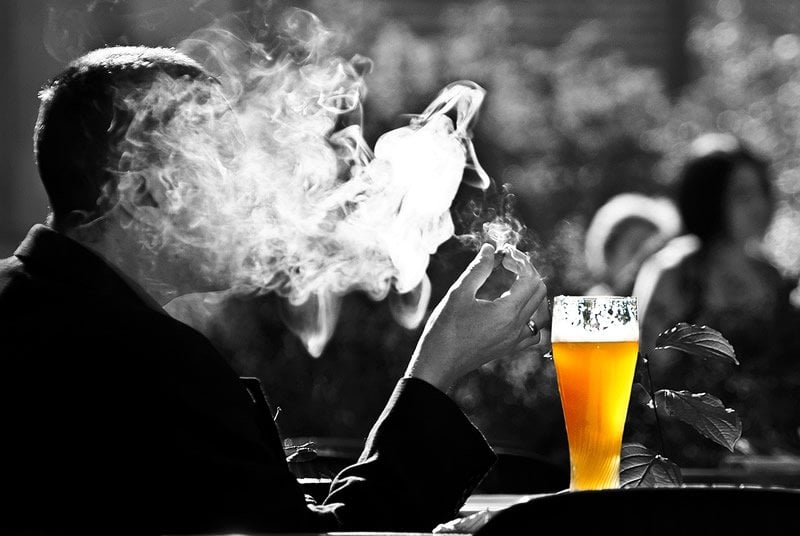Summary: Sadness, but not all negative emotions, heighten cravings to smoke and increases the likelihood of relapse.
Source: Harvard
What drives a person to smoke cigarettes – and keeps one out of six U.S. adults addicted to tobacco use, at a cost of 480,000 premature deaths each year despite decades of anti-smoking campaigns? What role do emotions play in this addictive behavior? Why do some smokers puff more often and more deeply or even relapse many years after they’ve quit? If policy makers had those answers, how could they strengthen the fight against the global smoking epidemic?
A team of researchers based at Harvard University now has fresh insights into these questions, thanks to a set of four interwoven studies described in a new report published in the Proceedings of the National Academy of Sciences: The studies show that sadness plays an especially strong role in triggering addictive behavior relative to other negative emotions like disgust.
The studies range from analysis of data from a national survey of more than 10,000 people over 20 years to laboratory tests examining the responses of current smokers to negative emotions. One study tested the volume and frequency of actual puffs on cigarettes by smokers who volunteered to be monitored as they smoked. While drawing from methodologies from different fields, the four studies all reinforce the central finding that sadness, more so than other negative emotions, increases people’s craving to smoke.
“The conventional wisdom in the field was that any type of negative feelings, whether it’s anger, disgust, stress, sadness, fear, or shame, would make individuals more likely to use an addictive drug,” said lead researcher Charles A. Dorison, a Harvard Kennedy School doctoral candidate. “Our work suggests that the reality is much more nuanced than the idea of ‘feel bad, smoke more.’ Specifically, we find that sadness appears to be an especially potent trigger of addictive substance use.”
Senior co-author Dr. Jennifer Lerner, the co-founder of the Harvard Decision Science Laboratory and Thornton F. Bradshaw Professor of Public Policy, Decision Science, and Management at Harvard Kennedy School, said the research could have useful public policy implications. For example, current anti-smoking ad campaigns could be redesigned to avoid images that trigger sadness and thus unintentionally increase cigarette cravings among smokers.
Lerner is the first tenured psychologist on the faculty of the Kennedy School. She was the Chief Decision Scientist for the U.S. Navy in 2018-19. Lerner has studied the impact of emotions on decision-making since the 1990s, examining issues including whether generalized negative emotions trigger substance abuse or whether a subset of specific emotions such as sadness are more important factors in addiction.
The other co-authors include Ke Wang, a doctoral student at the Kennedy School; Vaughan W. Rees, director of the Center for Global Tobacco Control at Harvard T.H. Chan School of Public Health; Ichiro Kawachi, the John L. Loeb and Frances Lehman Loeb Professor of Social Epidemiology at the Chan School; and Associate Professor Keith M.M. Ericson at the Questrom School of Business at Boston University. The work was funded by grants from the National Science Foundation and the National Institutes of Health.

Here are further details on the techniques and key findings of the four studies:
- Examining data from a national survey that tracked 10,685 people over 20 years, the researchers found that self-reported sadness among participants was associated with being a smoker and with relapsing back into smoking one and two decades later. The sadder individuals were, the more likely they were to be smokers. Notably, other negative emotions did not show the same relationship with smoking.
- Then the team designed an experiment to test causality: Did sadness cause people to smoke, or were negative life events causing both sadness and smoking? To test this, 425 smokers were recruited for an online study: one-third were shown a sad video clip about the loss of a life partner. Another third of the smokers were shown a neutral video clip, about woodworking; the final third were shown a disgusting video involving an unsanitary toilet. All participants were asked to write about a related personal experience. The study found that individuals in the sadness condition – who watched the sad video and wrote about a personal loss – had higher cravings to smoke than both the neutral group and the disgust group.
- A similar approach in the third study measured actual impatience for cigarette puffs rather than mere self-reported craving. Similar to the second study, nearly 700 participants watched videos and wrote about life experiences that were either sad or neutral, and then were given hypothetical choices between having fewer puffs sooner or more puffs after a delay. Those in the sadness group proved to be more impatient to smoke sooner than those in the neutral group. That result built upon previous research findings that sadness increases financial impatience, measured with behavioral economics techniques.
- The fourth study recruited 158 smokers from the Boston area to test how sadness influenced actual smoking behavior. Participants had to abstain from smoking for at least eight hours (verified by carbon monoxide breath test). They were randomly assigned to sadness or neutral control groups; smokers sat in a private room at the Harvard Tobacco Research Laboratory, watched the sad video and wrote about great loss, or watched a neutral video and wrote about their work environment. Then they smoked their own brand through a device that tested the total volume of puffs and their speed and duration. The results: smokers in the sadness condition made more impatient choices and smoked greater volumes per puff.
Lerner said the research team was motivated in part by the deadly realities of smoking: tobacco use remains the leading cause of preventable death in the United States despite five decades of anti-smoking campaigns. The global consequences are also dire, with one billion premature deaths predicted across the world by the end of this century.
“We believe that theory-driven research could help shed light on how to address this epidemic,” Dorison said. “We need insights across disciplines, including psychology, behavioral economics and public health, to confront this threat effectively.”
Source:
Harvard
Media Contacts:
James F. Smith – Harvard
Image Source:
The image is in the public domain.
Original Research: Closed access
“Sadness, but not all negative emotions, heightens addictive substance use”. Charles A. Dorison et al.
PNAS doi:10.1073/pnas.1909888116.
Abstract
Sadness, but not all negative emotions, heightens addictive substance use
Do negative feelings in general trigger addictive behavior, or do specific emotions play a stronger role? Testing these alternative accounts of emotion and decision making, we drew on the Appraisal Tendency Framework to predict that sadness, specifically, rather than negative mood, generally, would 1) increase craving, impatience, and actual addictive substance use and 2) do so through mechanisms selectively heightened by sadness. Using a nationally representative, longitudinal survey, study 1 (n = 10,685) revealed that sadness, but not other negative emotions (i.e., fear, anger, shame), reliably predicted current smoking as well as relapsing 20 years later. Study 2 (n = 425) used an experimental design, and found further support for emotion specificity: Sadness, but not disgust, increased self-reported craving relative to a neutral state. Studies 3 and 4 (n = 918) introduced choice behavior as outcome variables, revealing that sadness causally increased impatience for cigarette puffs. Moreover, study 4 revealed that the effect of sadness on impatience was more fully explained by concomitant appraisals of self-focus, which are specific to sadness, than by concomitant appraisals of negative valence, which are general to all negative emotions. Importantly, study 4 also examined the topography of actual smoking behavior, finding that experimentally induced sadness (as compared to neutral emotion) causally increased the volume and duration of cigarette puffs inhaled. Together, the present studies provide support for a more nuanced model regarding the effects of emotion on tobacco use, in particular, as well as on addictive behavior, in general.







